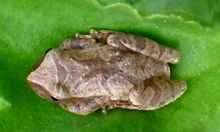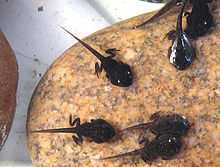Spring peeper
| Spring peeper | |
|---|---|
 | |
| Pseudacris crucifer | |
| Conservation status | |
| Scientific classification | |
| Kingdom: | Animalia |
| Phylum: | Chordata |
| Subphylum: | Vertebrata |
| Class: | Amphibia |
| Order: | Anura |
| Family: | Hylidae |
| Genus: | Pseudacris |
| Species: | P. crucifer |
| Binomial name | |
| Pseudacris crucifer (Wied-Neuwied, 1838) | |
| Synonyms | |
| |
The spring peeper (Pseudacris crucifer)[1] is a small chorus frog widespread throughout the eastern USA and Canada.
Etymology and taxonomy
Subspecies
There are two subspecies of the spring peeper, the northern (P. c. crucifer) and the southern spring peeper (P. c. bartramiana). The northern is similar to the southern except for a strong dark marking on the southern frog's belly. P. c. bartramiana is found along the southern Gulf Coast from south eastern Texas to northern Florida and southern Georgia, while the northern can be found all over the eastern USA and eastern Canada.
Nicknames
On Martha's Vineyard, peepers are commonly called "pinkletinks"; in New Brunswick, Canada, they are sometimes called "tinkletoes", although not commonly known by that name, and usually referred to as simply "peepers". On Nova Scotia's South Shore, they are sometimes referred to as "pink-winks."
Anatomy and physiology

The species has large toe pads for climbing, although it is more at home amid the loose debris of the forest floor.[3]

Ecology

Spring peepers primarily live in forests and regenerating woodlands near ephemeral or semipermanent wetlands.[5] This amphibious species requires marshes, ponds, or swamp regions to support the aquatic environment the eggs and tadpoles need.
In the northern reaches of their range, spring peepers must frequently endure occasional periods of subfreezing temperatures during the breeding season. The species can tolerate freezing of some of its body fluids, and undergoes hibernation under logs or behind loose bark on trees.[3] It is capable of surviving freezing of their internal body fluids to temperatures as low as -8°C.[6] This species frequently occurs in breeding aggregations of several hundred individuals, and commonly breeds in many small wetlands, including swamps and temporary pools and disturbed habitats, such as farm ponds and borrow pits.[5]
Geographic range and habitat
The southern spring peeper's habitat includes the Gulf Coast from southeastern Texas to southeastern Georgia and northern Florida, United States. Its northern conspecific occurs in the entire United States east of the Mississippi and spreads to eastern and central Canada.[3][5]
Behavior
Diet
Spring peepers are nocturnal carnivores, emerging at night to primarily feed on small invertebrates, such as beetles, ants, flies, and spiders.[3] They do not climb high into trees, but hunt in low vegetation. Spring peepers living in deep, damp forests are active hunters both day and night, whereas those found in woodland edges restrict most hunting and other activity to night.[4]
Tadpoles feed on algae and other organisms in the water. Their predators include great diving beetle larvae (when in tadpole form), snakes, skunks, and larger frogs.
Vocalization
 |
Single spring peeper calling
The call in relative isolation from others.
Collective spring peepers calling
A few hundred in a single pond.
|
| Problems playing these files? See media help. | |
As their common name implies, the spring peeper has a high-pitched call similar to that of a young chicken, only much louder and rising slightly in tone. They are among the first frogs in the regions to call in the spring.[7] As a chorus, they resemble the sounds of sleigh bells.[8] They are heard early in spring not long after the ice melts on the wetlands.[4] The males usually call from the edges of the bodies of water in which they breed, hidden near the bases of shrubs or grasses. Even when calling, they may be difficult to locate, and are most easily seen when in amplexus in the shallows. As in other frogs, an aggressive call is made when densities are high. This call is a rising trill closely resembling the breeding call of the southern chorus frog (Pseudacris nigrita nigrita).[5]
Breeding and reproduction

Spring peepers breed in southern areas from October to March, depending on the local temperature. In northern areas, they breed between March and June, when the warm rains start. P. crucifer typically lays around 900 eggs per clutch, but up to 1000 are possible. Egg clusters are hidden under vegetation or debris at the water base. After hatching, they transform into frogs and are ready to leave the water in about eight weeks. In very cold weather, they hibernate under logs and loose bark. Spring peepers often call day and night as long as the temperature is above freezing, but they are mostly heard and usually not seen because they hide in dense plants. They are especially easy to hear due to their extremely loud mating call which gives them the name "peeper", but it is often hard to pinpoint the source of the sound, especially when many are peeping at once. The peepers generally breed close to dusk and throughout the evening and early morning hours. Their calls can be heard from as far as one to two and a half miles, depending on their numbers. The spring peeper can live an estimated three years in the wild.[3]
Conservation status
The spring peeper has no special status in most areas. They are common and widespread frogs in the eastern regions. However, their habitats are quickly changing due to loss of wetlands. In some areas, their populations have decreased significantly.[8]
The species is listed as threatened in both Iowa[8] and Kansas.[9]
References
- ↑ ITIS Pseudacris crucifer (Integrated Taxonomic Information System). www.itis.gov.
- ↑ http://www.etymonline.com/index.php?search=crucifer&searchmode=none
- ↑ 3.0 3.1 3.2 3.3 3.4 3.5 3.6 "Spring Peeper Profile". National Geographic Society. Retrieved 2009-11-15.
- ↑ 4.0 4.1 4.2 4.3 LeClere, Jeff. "Spring Peeper - Pseudacris crucifer". HerpNet. Retrieved 2009-11-15.
- ↑ 5.0 5.1 5.2 5.3 "Spring Peeper". U.S. Geological Survey. Retrieved 2009-11-15.
- ↑ Adaptations of Frogs to Survive Freezing
- ↑ "Pseudacris crucifer". Maryland Department of Natural Resources9.
- ↑ 8.0 8.1 8.2 "Spring Peeper". The Regents of the University of Michigan. BioKIDS. Retrieved 19 November 2009.
- ↑ "Pseudacris crucifer". The Regents of the University of Michigan and its licensors. Retrieved 19 November 2009.
External links
 Media related to Pseudacris crucifer at Wikimedia Commons
Media related to Pseudacris crucifer at Wikimedia Commons Data related to Pseudacris crucifer at Wikispecies
Data related to Pseudacris crucifer at Wikispecies- Hammerson (2004). Pseudacris crucifer. 2006. IUCN Red List of Threatened Species. IUCN 2006. www.iucnredlist.org. Retrieved on 12 May 2006. Database entry includes a range map and justification for why this species is of least concern
- Spring Peeper Species account from the Iowa Reptile and Amphibian Field Guide
- "EEK! - Critter Corner - Northern Spring Peeper". dnr.state.wi.us. Retrieved 6 March 2012.
- Spring peeper, Natural Resources Canada
| Wikisource has the text of the 1920 Encyclopedia Americana article Peeper. |

.jpg)